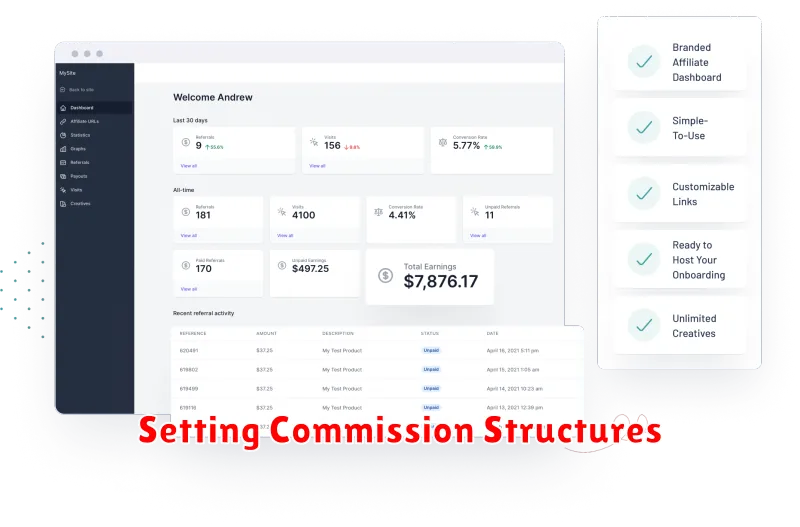Want to boost your sales and expand your reach? Launching a successful affiliate program can be the key. A well-structured affiliate program can drive significant revenue growth by leveraging the marketing power of others. This comprehensive guide will provide you with the essential steps to build, launch, and manage a thriving affiliate program that delivers impressive results. Learn how to recruit top-performing affiliates, track their success, and provide the resources they need to effectively promote your products or services. This is your roadmap to affiliate marketing success.
From defining your target audience and selecting the right affiliate platform to crafting compelling offers and providing ongoing support, this article covers every crucial aspect of building a high-performing affiliate program. Whether you’re a seasoned entrepreneur or just starting out, understanding the nuances of affiliate marketing is essential for maximizing your return on investment. Discover the secrets to attracting and retaining high-quality affiliates who will become valuable extensions of your sales team, driving traffic and increasing conversions. Dive in and unlock the potential of a powerful affiliate program for your business.
What Is Affiliate Marketing?
Affiliate marketing is a performance-based marketing strategy where a business rewards one or more affiliates for each visitor or customer brought about by the affiliate’s own marketing efforts.
Think of it as a commission-based system. The affiliate, often an individual or another business, promotes the merchant’s products or services. When a customer makes a purchase through the affiliate’s unique referral link, the affiliate earns a commission. This commission is a percentage of the sale or a fixed amount, predetermined by the merchant.
Key players in affiliate marketing include the merchant (the seller or brand), the affiliate (the promoter), the customer (the buyer), and often an affiliate network (a platform connecting merchants and affiliates). The affiliate network is not always necessary, but it can streamline the process, especially for larger programs.
Benefits of affiliate marketing for merchants include expanded reach, increased brand awareness, and a cost-effective marketing strategy where payment is contingent on results. Affiliates benefit by earning passive income and having the flexibility to promote products they believe in.
Is It Right for Your Business?
An affiliate program isn’t a one-size-fits-all solution. Careful consideration of your business model, resources, and goals is crucial. Ask yourself: does your business have a product or service with broad appeal? A niche product with a dedicated following can also be successful, but mass appeal often translates to more potential affiliates.
Consider your profit margins. Can you afford to share a percentage of your profits with affiliates? Factor in the costs of managing the program, including software, affiliate recruitment, and potential bonuses. Sustainable profitability is key.
Do you have the internal resources to manage an affiliate program? This includes tracking affiliate performance, processing commissions, and providing marketing materials. If not, outsourcing program management is a viable option, but adds to the overall cost.
Finally, assess your marketing goals. Are you looking to increase brand awareness, drive sales, or both? A well-structured affiliate program can be a powerful tool to achieve these objectives, but it requires strategic planning and consistent effort.
Setting Commission Structures

A well-defined commission structure is crucial for attracting and motivating affiliates. Consider your profit margins and industry benchmarks when determining the commission percentage or flat rate you’ll offer. Common structures include:
- Percentage-based: Affiliates earn a percentage of each sale generated through their referral link (e.g., 10% of the sale value). This is a popular choice due to its scalability.
- Tiered commissions: Motivate affiliates to drive higher sales volumes by offering increasing commission percentages as they reach specific milestones.
- Flat-rate commissions: Affiliates earn a fixed amount for each successful referral. This structure offers simplicity but might not incentivize higher sales volumes.
- Bonus or Performance Incentives: Offer rewards for exceeding targets or achieving specific milestones.
Clearly outline the payment terms, including payment frequency (e.g., monthly, bi-weekly) and methods (e.g., PayPal, bank transfer). Ensure your commission structure is competitive, sustainable, and attractive to potential affiliates within your niche.
Recruiting the Right Affiliates
Recruiting the right affiliates is crucial for the success of your program. Quality over quantity should be your guiding principle. Focus on finding affiliates who align with your target audience and brand values. An affiliate with a large, but irrelevant, audience won’t drive meaningful conversions.
Consider affiliates who have a proven track record of success in affiliate marketing. Look for engagement metrics like click-through rates and conversion rates, rather than just follower counts. Affiliates who are passionate and knowledgeable about your niche are more likely to generate genuine interest in your products or services.
Several avenues exist for finding potential affiliates. You can leverage affiliate networks, which offer a platform to connect with a wide range of affiliates. Directly reaching out to influencers or bloggers in your industry is another effective method. Social media platforms can also be useful tools for identifying potential partners.
Vetting potential affiliates is essential. Review their website or social media presence to assess their content quality and audience engagement. Consider their communication style to ensure it aligns with your brand’s image. Choosing the right affiliates is an investment in your program’s long-term success.
Creating Promotional Materials
Creating compelling promotional materials is crucial for the success of your affiliate program. These materials equip your affiliates with the resources they need to effectively market your products or services. Providing a variety of ready-to-use materials saves them time and effort, encouraging greater participation.
Essential promotional materials include high-quality banners in various sizes. These visuals should be eye-catching and clearly communicate your brand and offer. Text links are also vital, providing simple and versatile options for integration into different content formats.
Consider providing email templates that affiliates can customize and send to their audience. Pre-written social media posts are another valuable asset, facilitating quick and easy sharing across various platforms. Product descriptions, sample tweets, and suggested Facebook posts are all helpful examples.
A dedicated affiliate resource center containing all these materials, along with program guidelines and FAQs, ensures easy access and promotes program engagement.
Tracking Sales and Payouts
Accurate tracking is crucial for a successful affiliate program. You need to reliably attribute sales to the correct affiliates to ensure fair compensation.
Several methods exist for tracking sales. Affiliate links with unique identifiers are the most common. These allow you to monitor which affiliate referred the customer. Cookies stored on the customer’s browser can also track referrals, although they can be less reliable due to browser settings and clearing.
Payout structures vary. Cost per sale (CPS) is a popular model where affiliates earn a commission on each sale they generate. Cost per lead (CPL) focuses on leads generated, while cost per click (CPC) pays affiliates for each click on their affiliate link.
Choose a reliable tracking platform. Many affiliate management software solutions are available, offering features like real-time reporting, automated payouts, and fraud detection.
Establish a clear payout schedule. Whether it’s weekly, bi-weekly, or monthly, ensure timely and consistent payments to maintain affiliate satisfaction.
Legal Considerations and Disclosures
Launching an affiliate program requires careful attention to legal compliance. Disclosure is paramount. The Federal Trade Commission (FTC) mandates clear and conspicuous disclosure of affiliate relationships to consumers. This means informing your audience that you may receive a commission for purchases made through affiliate links.
Affiliate agreements should be robust and clearly outline the terms and conditions of the program, including commission structures, payment schedules, and responsibilities of both parties. These agreements help prevent misunderstandings and protect both the merchant and the affiliate.
Data privacy is another crucial aspect. Ensure your program complies with data privacy regulations like GDPR and CCPA. Be transparent with affiliates and customers about how data is collected, used, and protected. Compliance with these regulations is essential to building trust and avoiding legal penalties.
Consulting with a legal professional specializing in online marketing and advertising law is highly recommended. They can provide tailored guidance on navigating the complex legal landscape surrounding affiliate programs and ensure your program is compliant with all applicable laws and regulations.
Optimizing Affiliate Performance
Continuously monitoring affiliate performance is crucial for program success. Track key metrics such as conversion rates, average order value (AOV), and click-through rates (CTR) to identify top performers and areas for improvement.
Provide your affiliates with the resources they need to succeed. This includes high-quality marketing materials like banners, email templates, and product descriptions. Consider offering exclusive promotions and incentives to motivate increased performance. Regular communication and feedback are also essential. Share best practices, product updates, and performance reports to keep affiliates engaged and informed.
Tiered commission structures can incentivize top performers by offering higher commission rates for achieving specific sales targets. This encourages healthy competition and rewards those driving significant results.
Regularly review and refine your program based on performance data. Identify any underperforming affiliates and offer support or consider removing them from the program. Stay adaptable and make adjustments as needed to maximize program effectiveness.
Preventing Fraud and Abuse
Fraud and abuse can significantly impact the success of your affiliate program. It’s crucial to implement preventative measures from the start.
Regularly monitor affiliate activity. Look for suspicious patterns such as sudden spikes in conversions, a high number of returns, or unusually high traffic from a single source. Use analytics platforms to track key metrics and identify potential issues.
Establish clear terms and conditions within your affiliate agreement. Explicitly outline prohibited activities, such as cookie stuffing, fake traffic generation, and misleading advertising. Enforce these terms consistently.
Consider using fraud detection software. These tools can automate the process of identifying suspicious activity and alert you to potential problems. They can also help to block fraudulent conversions before they impact your bottom line.
Vet your affiliates carefully. While not foolproof, a thorough vetting process can help to weed out potentially problematic affiliates before they join your program. Look for established affiliates with a proven track record of success.
Tools to Run Affiliate Programs
Several tools can streamline the management and growth of your affiliate program. Choosing the right tools depends on the size and complexity of your program. For smaller programs, simple spreadsheet tracking might suffice initially. However, as your program scales, dedicated affiliate management software becomes crucial.
Affiliate marketing software automates many processes, such as tracking referrals, calculating commissions, and generating reports. These platforms provide a centralized dashboard to manage affiliates, monitor their performance, and process payments. Some popular options offer features like fraud detection, tiered commission structures, and customizable dashboards.
Beyond dedicated software, other tools can support your program. Communication tools like email marketing platforms or dedicated affiliate communication portals facilitate streamlined communication with your affiliate partners. Link tracking software allows for precise monitoring of affiliate-generated traffic and conversions. Finally, consider reporting and analytics tools to gain deeper insights into your program’s performance and identify areas for optimization.

